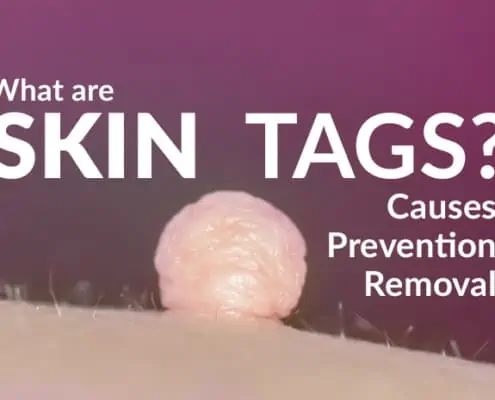
OC 949-428-4500
LA 310-460-2444

You are shaving… You notice a few small bumps on your skin… They kind of look like pimples but not really… Are they hives, insect bites?… Nope, turns out they are ingrown hairs!
Don’t panic, ingrown hairs are actually quite common, generally harmless and easy to treat.
An ingrown hair occurs when the hair grows back into the hair follicle, or surrounding skin, instead of out of it.
There are several different things that can cause this but usually it is the result of something (dead skin / dirt) clogging the follicle and thus re-routing the natural growth pattern of the hair. Also, hair that is super curly is more susceptible to becoming ingrown regardless if the follicle is clogged or not.
However they form, ingrown hairs are annoying. We can all agree on that. That is why we wrote this article on how to remove ingrown hairs and better yet, how to prevent them from even forming in the first place.
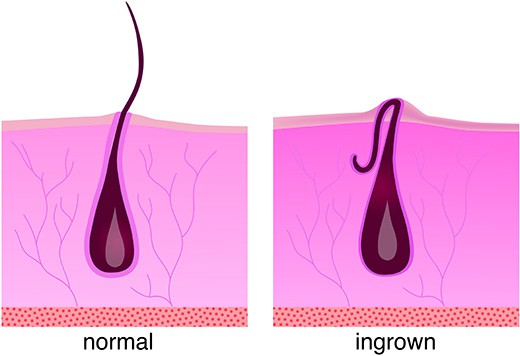
While annoying, most ingrown hairs will resolve on their own in a few days or so. However, there are several different methods in which to help this process along. This will also prevent the ingrown hair from getting worse and possibly turning into a giant, inflamed, ingrown hair cyst.
Below are tips on how to remove ingrown hairs at home as well as some medical-based treatments should the at-home remedies not work.
Most of the time ingrown hairs can be dealt with using one of the many at-home remedies listed below. These treatments work best when the ingrown hair initially forms. It is always best to deal with it right away an not let it turn into something far worse.
Using warm compresses to soften the skin will allow you to extract the hair if it isn’t embedded too deep. If you can see the hair embedded in the skin this treatment will usually work.
Even if the hair is embedded deep in the skin, warm compresses can help to draw the hair closer to the surface. You want the hair as close to the surface of the skin as possible to make the extraction as easy as possible.
If you experience pain or the hair has not freed itself then you will need to break out the tools such as tweezers or other sharp instrument. Do this only if you can see the looped hair. You don’t want to go digging in your skin hoping to get lucky and find the offending hair.
Used in combination with warm compresses, tweezers will help to gently ease the hair out of the skin. If tweezers aren’t available, a sewing needle or safety pin can also be used.
There are a few key steps to follow to ensure the entire hair is removed. This will prevent future ingrown hairs and the pain of having to do this all over again.
This method works best when you are able to see the loop of the ingrown hair close to the surface of the skin.
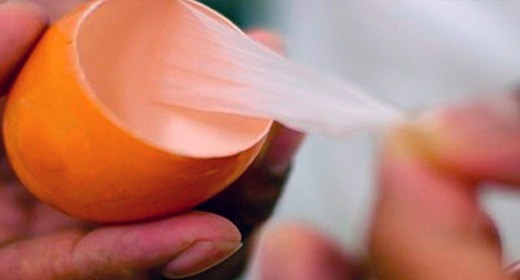
In-between the eggshell and the egg white is a transparent protein membrane made partly of keratin that is surprisingly strong.
This membrane can be used to pull the hair out of the skin. This method of resolving an ingrown hair is preferred over the tweezer method as it is less damaging to the surrounding skin.
Removing an ingrown hair with an egg membrane is quite simple:
The egg membrane will grab onto the hair and should help it to come out of the follicle as you peel it off the skin.
Benzoyl peroxide is commonly found in over the counter acne medications. A twice a day application will help dry up the affected area, reduce redness and provide the hair the room it needs to grow outward.
It typically take several days or weeks to start seeing the positive effects of this treatment.
When the above at-home remedies aren’t working to remove your ingrown hair it’s time to consider seeing a doctor or dermatologist. The following treatments are the most commonly used to expedite the removal of ingrown hairs.
A will likely be the first treatment suggested by a medical professional. This cream helps to reduce “skin plugging” by thinning out the top layer of the skin and reducing the build-up of dead skin cells. This will reduce the likelihood of hair being able to embed in the follicle. It also helps to reduce the healing time of ingrown hairs that have already developed.
Topical corticosteroid creams are used to reduce inflammation in the skin. This will give the hair more room to begin growing normally again.
Severe ingrown hairs that turn into pustules or abscesses are signs of a secondary infection within the hair follicle. When this occurs topical antibiotics such as erythromycin or clindamycin are prescribed to treat the infection.
Once the bacteria is gone and the skin begins to heal the hair can start growing outward again.
For those that experience frequent ingrown hairs, or large numbers of them at the same time, laser hair removal may be the best option for you.
Laser hair removal will permanently remove the offending hairs eliminating the possibility of future ingrown hairs from forming. It is fast, safe and can be performed on every part of the body, even the face.
Another option to permanently remove the offending hairs is electrolysis. This procedure can be used to target individual follicles and works on just about any color of hair.
The electrolysis procedure is often tedious but the hair follicles are destroyed permanently so you won’t have to do it forever.
All the treatments listed above for dealing with ingrown hairs are generally safe and effective. The main thing to remember when removing an ingrown hair is to be as gentle as possible so as not to damage the follicle or surrounding skin.
As the old saying goes “an ounce of prevention is worth a pound of cure” so with that being said, below are our tips on how to prevent ingrown hairs from forming in the first place.
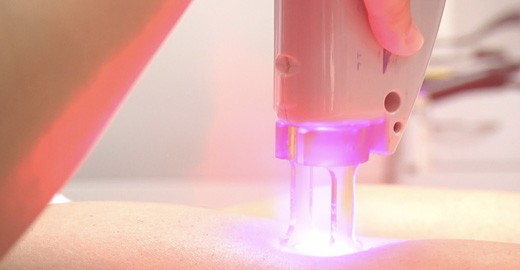
If you are prone to developing ingrown hairs one of the best things you can do is learn how to prevent them.
The following tips will help keep you well groomed and ingrown hair free.
Chances are you are probably using one of the three most common hair removal techniques, shaving, waxing, or epilation. These are actually the main culprits that cause ingrown hairs. Choosing a different method of removing hair that is not know to cause ingrown hairs is the first step in prevention.
Techniques that are not know to cause ingrown hairs include include depilatory creams, electrolysis, and IPL. These either dissolve the hair protein or kill the hair follicle entirely making it easier for the hair to grow back correctly, if at all.
Weigh the pros and cons of each before making a final decision. Cost may be an issue you run into.
A simple way to prevent ingrown hairs is learning the correct technique when shaving.
To get a closer shave many people have been taught to pull the skin tight. While this does work to get a closer shave, it can also cause the hair to get stuck beneath the skin when you release the tension. With the hair stuck beneath the skin it tends to reenter the skin without first growing upright.
Using a multiple-bladed razor will allow you to get the close shave you want without the need to pull the skin tight.
Also, experts suggest waiting until the end of your shower to shave. The hot water softens and smooths the hair and skin giving you a closer shave with less risk of ingrown hairs.
Immediately after shaving, waxing or epilation it is important to sooth and nourish your skin. Skin hydration is key and there are a wide variety of products available to help you achieve this. Everyone is different so it may take some experimenting to find the one that is just right for your unique skin.
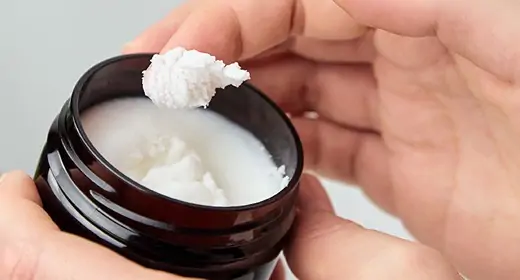
Preventing ingrown hairs can be as simple as taking good care of your skin. Exfoliate, cleanse and moisturize on a regular basis.
Exfoliation helps to remove dead skin cells that oftentimes lodge themselves inside hair follicles. This prevents the hair from growing upward and out resulting in an ingrown hair. Exfoliating one to two times a week can make a huge difference in the number of ingrown hairs you experience.
Cleansing also helps to to keep your hair follicles free from clogs by removing dead skin cells, dirt, and other debris. A mild cleanser works best, applied in circular motions across your face. Not only does this cleanse you skin but also stimulates blood flow to the area nourishing your skin cells and keeping them vital.
Moisturizing brings nourishing hydration to both the skin and the hair. It is helpful in preventing ingrown hairs because it reduces the chances of hair breaking at the surface during hair removal.
Using products that your skin does not like can dry it out and cause irritation. Unhappy skin results in more frequent, and more painful, ingrown hairs.
Skincare products that contain natural ingredients and soothing components are ideal. If a product makes your skin feel tight and dry after use chances are it’s not the right one for your skin. Trust what your skin is telling you. It knows what it likes.
The way you treat an existing ingrown hair can directly affect whether another one will show up in the future. Avoid scratching, picking or squeezing as these will irritate the area and further damage the skin.
The detailed steps above are the best way to treat an ingrown hair and prevent future ones. To sum up…
After a few days of doing the above routine the hair should become free and any irritation in the skin should subside.
Your clothing can actually be what is causing ingrown hairs to form. Tight-fitting clothing that hugs the skin makes it difficult for hair to grow in its natural direction.
The fabric itself is also contributing as it causes pressure and friction on the hair follicles. This increases the likelihood that the hair will grow back inwards.
To prevent you clothes from being the cause of ingrown hairs avoid tight-fitting clothing as much as possible.
If cost is not a concern then a treatment like laser hair removal to permanently remove hair is a surefire way to prevent ingrown hairs.
Laser hair removal treatments not only eliminate the hassle of constant hair removal but also pretty much eliminate the possibility of ingrown hairs.
While ingrown hairs don’t usually pose any major health concerns they can definitely be a pain and an embarrassment. If you stay vigilant you can certainly prevent the majority of ingrown hairs from forming and improve the overall health of your skin while you are at it.
Remember, use the right products for your skin, switch up your hair removal technique and listen to what your skin wants and you will be on your way to ingrown hair free skin in no time.
AMA Regenerative Medicine & Skincare | 1570 Brookhollow Dr., Santa Ana, CA 92705 | 6310 San Vicente Blvd STE 285, Los Angeles, CA, 90048 | Privacy Policy